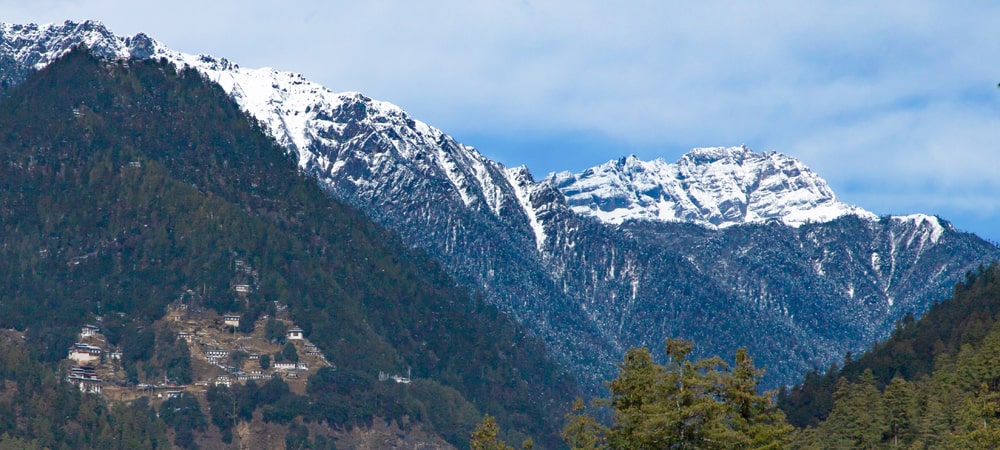
Are you planning a trip to Bhutan? Do you want to explore the Bhutanese natural wonders? Do you wonder how different is Bhutan’s nature from any other country in the world?
Bhutan, an Asian Buddhist landlocked nation, is indeed one of the most beautiful countries in the world to explore and experience. The country is well-known for its dramatic mountainous scenery, stunning monasteries, and extensive festivals and cultural traditions. Despite being one of the world’s tiny nations, Bhutan’s dedication to conserving its nature & ecosystem is remarkable. Bhutan is the first carbon-negative country in the world, and she has been preserving her nature like mother care for her baby.
The natural environment of Bhutan, featuring steep, Rocky Mountains and deep valleys, supports a variety of habitats. Bhutan is home to a wide range of species, even though it lacks many endemic mammals or animals. The Takin is Bhutan’s national animal. Many biologists are confused by the Takin since they are unable to connect it to any other species. Because of the hump on its snout and its size, which is similar to a North American moose, it is known as the “bee stung moose.”
Bhutan has managed to keep one of the planet’s most untouched ecosystems by choosing to stay cut off from the outside world for many years. It was listed among the top ten biodiversity hotspots in the world in 1998. The people of Bhutan are tremendously aware of the natural environment, and they work very hard to protect the nature of Bhutan alongside the government.
The Bhutanese people place a high value on the country’s natural beauty and wildlife, and the local community and the government work hard to preserve it. Bhutan is a nature lover’s paradise with four sizable national parks and numerous animal reserves. If you are a nature lover, you can choose Bhutan as a wonderful destination to visit.
Planning to visit Bhutan? Find the best and most highly rated Bhutan travel providers by visiting our 10 best-reviewed and highest-rated Bhutan tour companies articles Also, you can find the best Bhutan travel packages and offers from our Bhutan tour deals page.
Almost 35% of Bhutan’s land is protected or managed for conservation purposes. The Royal Government of Bhutan has promised to keep the forest cover at least 60% at all times (it is now at 65%). The government frequently votes against abandoning natural resources in favor of short-term economic endeavors and benefits, which is unusual for many other countries. The country has also banned mountaineering in its alluring mountains since 1994. This is the reason Bhutan has the world’s highest virgin mountains.
In addition to a large number of nature reserves and wildlife sanctuaries, Bhutan has four declared national parks. The western Bhutanese cities of Paro, Thimphu, and Punakha are home to the Jigme Dorji National Park, which provides a habitat for several endangered species, including the takin, blue sheep, and more. There are many hotels and restaurants in these pristine natural cities from where you can explore the amazing surrounding views.
In south-central Bhutan, the Royal Manas National Park protects a variety of animals, including rhinos, buffalo, tigers, leopards, elephants, and many more. There are plans to allow visitors into the park. The mountain range separating eastern and western Bhutan is protected by Black Mountain National Park.
It is home to a variety of indigenous vegetation as well as fauna like tigers, leopards, red pandas, and Himalayan black bears. Finally, the temperate forest is protected by Thrumshing la National Park, which is situated halfway between Bumthang and Mongar. It is also a well-known place for bird protection.
Since there is no actual economic value placed on Takin parts, hunting these animals is prohibited by law, and poaching is therefore rare. Snow leopards, blue sheep, red pandas, and tigers can be found in Bhutan’s higher elevations, whereas leopards, grey langurs, sambhar deer, one-horned rhinos, and elephants can be found in the country’s lower, temperate tropical zones.
Bhutan is home to over 670 different bird species as a result of its location at the intersection of a significant avian migration path. For sixteen highly endangered bird species, including the uncommon Black Necked Crane, Bhutan is regarded as a “haven.”
Bhutan is also best known for its appealing river valleys, charming Himalayan vistas, and high hills that host several quaint and sacred monasteries. The valleys and hills are untouched by modernity and its natural phenomena remain pristine at their best. The kingdom of Bhutan is also untouched by the effects of global warming, making the weather pattern natural.
Bhutan Nature: FAQs
Bhutan is one of the ten most significant biodiversity “hotspots” in the world due to its steep, rocky mountains and deep valleys, which are teeming with amazing species. Bhutanese people have valued nature for a very long time and consider it to be the source of all life.
The natural environment of Bhutan features steep mountains and deep valleys and supports a variety of habitats. Given the significance of the environment, one of the government’s development paradigms is the preservation of its rich biodiversity.
Bhutan prohibited plastic bags in 1999. It was significant. But since then, the Environmental Commission has had to reiterate the restriction three times since, despite the rule being in existence, the issue hasn’t gone away after 20 years.